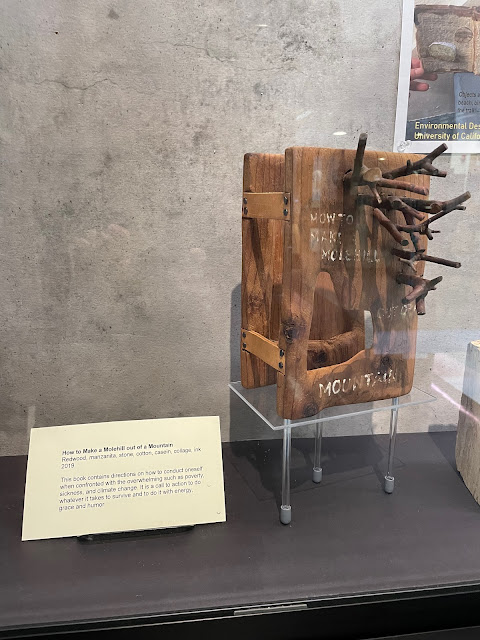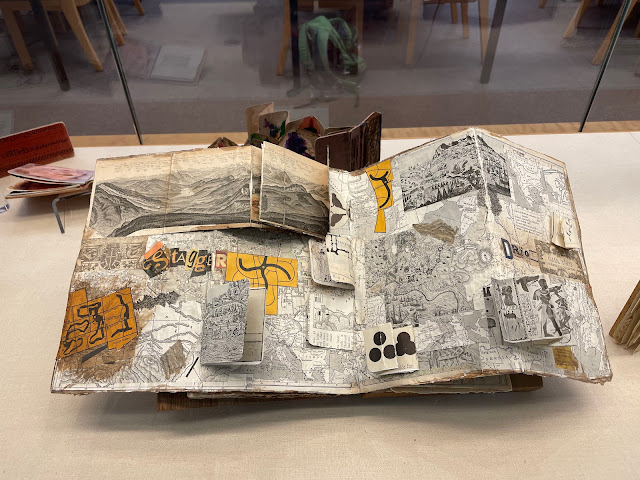Slipped between side streets in a residential neighborhood up the hill, the flowers, pools, house, and forest of Blake Garden provide a respite from the city, even as the garden overlooks the bridges and skyscrapers of San Francisco and the bay itself. Although it covers 10.5 acres, and is the property of UC Berkeley (a gift, meant to house the college's president), one has to know it is there in order to reach it. During these strange and difficult pandemic times I've found the garden to be a magical place to meet a friend for a chat and meander through the grounds, and I have been up there more in the past year than any other decade.
Looking out toward the Golden Gate Bridge.
There is even an oversized chessboard, with pieces made from downed wood.
It is not surprising, then, that an artist would feel inspired to respond to this elegant spot. On one recent visit, a friend pointed out a postcard for an exhibition of book art called "Reading the Landscape." The artist was Lauri Twitchell, a graduate of the school of Environmental Design at UCB, not someone I knew. According to various websites she had previously been the Blake Garden Manager, and holds a BFA in Painting, an MFA in printmaking from Indiana University, and a Masters in Landscape Architecture from UC Berkeley. The card said, "Objects and events – like finding rocks on the beach, birdsong in the woods, or sticks on the trail – all carry metaphorical significance." Her combined interests in nature, materials, and art made a visit to the show absolutely necessary for me.
The Environmental Design Library, on the Berkeley campus, is a light and airy, welcoming space inside the Brutalist concrete building that is Wurster Hall (now called Bauer Wurster hall, to affirm the contributions of Catherine Bauer Wurster, an early advocate of affordable housing, adviser, author, educator, and the other half of the Wurster couple). Twitchell's exhibition is in two long cases inside the library.
First, a few books in the hallway. I find the contrast between the wood and concrete and glass rather beautiful. Here is an accordion with an old panorama of mountains with stenciled letters that say, "Don't Panic." The accordion form echoes the mountain shapes. The yellow lettering reminds me of caution signs.
How to Make a Molehill out of a Mountain (2019)
Redwood, manzanita, stone, cotton, casein, collage, ink
The wall text says it contains directions on how to survive with "energy, grace and humor."
It is primarily a construction of wood, which I find curious.
Inside. Here are a few samples, below.
Rough Language (2018)
Rocks, wood, cotton, ink, collage
"'rough' words and 'rough' rocks"
Inclined to Decline (2020)
Cotton, ink, collage, birch bark
"decline of our environment"
Hide and Seek (2019)
Ceramics, wood, collage, ink
"Inspired by a favorite kids' game that trained us how to maneuver through the world."
I do not know if she has included this idea within the book itself, but I find fascinating the concept of this particular game as training us for life. This page has the word "read" on it, which, when you are beginning to learn to read, you could find the words first hidden in the letters, then found.
Great Fortune (32 Birdsongs) (1999)
Woodtype and woodcut; printed on Hosho paper with Japanese stab binding
"Graphic sound prints of bird songs."
The horizontal format of the side binding works well with these graphically interpreted sounds. The semi-translucent paper makes a nice layering effect. I like the idea of taking an image generated by machine and turning it into an image made by hand.
No Stone Unturned (2019)
Oak, stone, melaleuca paper bark, hemp, collage
Based on a Japanese garden concept of "hide and reveal," where one can only see something partially until one moves through the landscape, Twitchell says this book "contains an alternating text of synonyms of the antonyms hide and reveal.
I'm drawn to the wrapped stones and the assemblage. I think one can really feel how sensitive she is to natural materials.
Erratic (2018)
Collaged maps, redwood boards, leather, schist
"In geological terms 'erratic' refers to rocks found away from their origin. It comes from the Latin word 'error,' to wander. The book is a journey through collaged maps, images and texts, as examples of how you might find yourself as you wander throughout this world."
Here is another example where the concept is very interesting and can go very deep, reminding us of immigrants as well as rocks. Because we cannot see the whole book, we cannot tell if she has incorporated this concept into any text within. The collage is tactile and beckons us, particularly with its three-dimensional flaps and folds.
A Plan of Excursion DG (2019)
Decomposed granite, wood, leather, cotton, ink, graphite, collage
From the accompanying text I gather that the book began with the found board, "with the letters 'DG' stenciled on it…interpreted as an abbreviation for 'decomposed granite,' a material used for path surfacing." She then did rubbings of the ground and connected them in ways that resembled mapping. The drawings are carefully done and the sheer volume of the pages all stacked up make the book both appealing and give the reader the feeling of endless pathways.
Under (2017)
Cotton paper, twine, wood board, ceramic tile, silk
"Images of anthropomorphic roots are drawn in ink on walnut ink splattered pages" with synonyms for "under," "underground," "undergrowth," and "understory."
Here, as in a few other pieces, I appreciate the wordplay, but feel this would have been an ideal book for a personal story, journey, or something, well, deeper.
Covid and Me Series (9 books) (2020-2021)
Cotton, Conte crayon, watercolor, collage
These little books, which were essentially journals, documenting "real time," were clearly the most personal of all the works, perhaps because, being unable to travel outside, she had to travel inside. Much still appears hidden behind dictionary definitions and juxtapositions of words, but more of herself is revealed. From what I recall, these are the only books where people appear.
I'm very drawn to this hand and egg-shaped stone with the map on the back of the accordion fold book. Unfortunately, I did not document its title.
Here You Are (2015)
Chert, bark, cotton, and ink
"Commonplace sayings informed by landscape metaphors such as 'mountains of worry'" and "situations we often find ourselves in."
Duets (2001)
Screenprinted on aquaprint paper
"American Robin and Olive-Sided Flycatcher; Ovenbird and Yellow Warbler; Black and White Warbler and Northern Cardinal; Eastern Towhee and Chestnut-Sided Warbler; Black-Throated Green Warbler and Black-Throated Blue Warbler."
It is easier to remember bird songs when you give them people phrases. For the longest time I called a bird I heard in my yard the "tweedle deedle bird," until I became more invested in birds and found it was the Golden-crowned Sparrow. I am so curious why these birds were chosen, why they were paired, and where she heard them.
The two cases were quite full of Twitchell's books and sculptural objects, most very recent. You can understand the longtime imprint of her time as manager of Blake Garden. I also discovered you can see and purchase her work here at Vamp & Tramp Bookseller. And it looks like the book with the (handmade puppet) hand and stone is called Making Waves by Lauri Twitchell and Peter Suchecki (who appears to be a frequent collaborator) from 2018. The story of it is on that website, and I find it even more powerful now, thinking about all the people who have handled the stone.
In a third display case were twenty random artist books from the library's collection, by many a familiar name, including: Art Hazelwood, Clifton Meador, Rae Trujillo, Islam Aly, Alicia Bailey, Alice Austin, Ginger Burrell, Beata Wehr, Suzanne Thomas, and Barbara Milman.
An aside. Long ago, when I was a student and had friends studying architecture and landscape design at Berkeley, I was told that Wurster Hall was actually flipped East/West from how it was supposed to have been built. My friend took me around to the "back" and we noted how the steps leading up to the building really did look like they were supposed to be the front entrance. The "front," by contrast, seemed flat and non-welcoming. Several years later, a plaza with trees was added to the "front," as well as a café. Who would know it was ever otherwise? I wasn't able to find out anything online about this, so we'll just say it's a good story.
The Environmental Design Library is on the second floor of Bauer Wurster Hall, just out of the elevator (three people at a time in the elevator, please). Both Lauri Twitchell's and the collection's book art shows are scheduled to remain up until December 15. You can find the hours here. Another very pleasant place to wander.




















Comments
Also, the Blake Garden is an unexpected oasis and what a view.
I shall sit and wallow when I've addressed the groceries!
Thank you, Alisa.